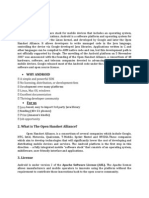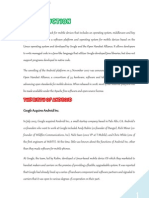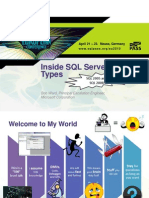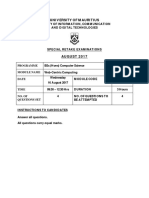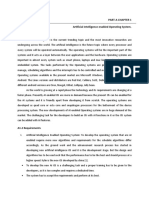C C C C C C C: Candroid Is Under Version 2 of The Apache Software
C C C C C C C: Candroid Is Under Version 2 of The Apache Software
Uploaded by
Madhu LalithCopyright:
Available Formats
C C C C C C C: Candroid Is Under Version 2 of The Apache Software
C C C C C C C: Candroid Is Under Version 2 of The Apache Software
Uploaded by
Madhu LalithOriginal Title
Copyright
Available Formats
Share this document
Did you find this document useful?
Is this content inappropriate?
Copyright:
Available Formats
C C C C C C C: Candroid Is Under Version 2 of The Apache Software
C C C C C C C: Candroid Is Under Version 2 of The Apache Software
Uploaded by
Madhu LalithCopyright:
Available Formats
ANDROID OS
to advancing open standards for mobile devices. Google released most of the Android code under the
ABSTRACT:
The Android operating system (OS) is widely used within several types of embedded & mobile platforms, including mobile phones and tablets, and the industry is exploring the ability of Android within other embedded platforms, i.e., automotive or military, that require real-time guarantees and the ability to meet deadlines as a pre-requisite for reliable operation. In this paper, we present preliminary conclusions on Androids real-time behavior based on experimental measurements performed on a commercially available Android platform. Apache license, a free-software and open source license.
3. ANDROID VERSIONS:
Android version has been developed under a codename based on a dessert item. These versions have released in alphabetical order. y Beta. y Android 1.0. y Android 1.1. y 1.5 Cupcake. y 1.6 Donut. y 2.0/2.1 Eclair. y 2.2. X Froyo. y 2.3. X Gingerbread. y 3. X Honeycomb. y 4. X Ice Cream Sandwich.
KEYWORDS:
Android, Android versions, Openhandset alliance, License, Platform, Software stack, Network connectivity, Security, Security architecture, Performance, Software development, Programming language, Advantages of android os, Features of android os.
1. INTRODUCTION: 4. OPEN HANDSET ALLIANCE:
Android is a new open source software toolkit for mobile phones that was created by Google and the Open Handset Alliance. In a few years, its expected to be found in millions of cell phones and other mobile devices, making Android a major platform for application developers. Open Handset Alliance, is a consortium of several companies which include Google, HTC, Intel, Motorola, Qualcomm, T-Mobile, Sprint Nextel and NVIDIA.These companies which aim to develop technologies that will significantly lower the cost of developing and distributing mobile devices and services. The Android platform is the first step in this direction -- a fully integrated mobile "software stack" that consists of an operating system, middleware, user-friendly interface and applications.
2. ANDROID:
Android is a software platform and operating system for mobile devices, based on the Linux kernel, and developed by Google and later the Open Handset Alliance. It allows developers to write managed code in the Java language, controlling the device via Google-developed Java libraries. Applications written in C and other languages can be compiled to ARM native code and run, but this development path is not officially supported by Google. The unveiling of the Android platform on 5 November 2007 was announced with the founding of the Open Handset Alliance, a consortium of 48 hardware, software, and telecom companies devoted
5. LICENSE:
Android is under version 2 of the Apache Software License (ASL). The Apache license allows manufacturers and mobile operators to innovate using the platform without the requirement to contribute those innovations back to the open source community.
6. PLATFORM: 6.1 HARDWARE:
First and foremost, android is a software stack for mobile devices. This means that high on the list of priorities is the preservation of battery power and the efficient management of limited memory resources. There are five distinct layers to the Android system stack:
Android applications are written in the Java programming language, and you can download many more from the Android market on the fly.
6.2 SOFTWARE STACK:
High on the list of priorities is the preservation of battery power and the efficient management of limited memory resources.
The Acorn RISC Machine (ARM) Linux core forms the solid base upon which all the other layers stand. Linux is a proven technology that is highly reliable, and the ARM processor family is known for high performance on very low power requirements. The libraries provide the reusable and sharable low-level code for basic functions such as codecs software for coding and decoding digital sound and video functions for the presentation of rich graphics on a small displays, secure shell support for encrypted TCP/IP traffic into the cloud, as well as component support for Web browsing (WebKit), SQL database functionality (SQLite), and standard C library functionality you would expect in a Linux system. The Dalvik run-time byte-code interpreter, which strongly resembles the Java language byte-code interpreter, adds a few distinct features that uniquely define the security and power-preserving model of Android. Every application currently running, for example, has its own user ID and its own copy of the interpreter running to strictly separate processes for security and reliability. The Android application framework enables you to use and replace components as you see fit. These high-level Java classes are tightly integrated components that define the Android API. The Android core applications include the WebKit browser, Google calendar, Gmail, Maps application, SMS messenger, and a standard e-mail client, among others.
Fig.1 Android Architecture Android uses Linux for its device drivers, memory management, process management, and networking. However you will never be programming to this layer directly. The next level up contains the Android native libraries. They are all written in C/C++ internally, but youll be calling them through Java interfaces. In this layer you can find the Surface Manager (for compositing windows), 2D and 3D graphics, Media codecs (MPEG-4, H.264, MP3, etc.), the SQL database (SQLite), and a native web browser engine (WebKit). Next is the Android runtime, including the Dalvik Virtual Machine. Dalvik runs dex files, which are converted at compile time from standard class and jar files. Dex files are more compact and efficient than class files, an important consideration for the limited memory and battery powered devices that Android targets. The core Java libraries are also part of the Android runtime. They are written in Java, as is everything above this layer. Here, Android provides a substantial subset of the Java 5 Standard Edition packages, including Collections, I/O, and so forth.
The next level up is the Application Framework layer. Parts of this toolkit are provided by Google, and parts are extensions or services that you write. The most important component of the framework is the Activity Manager, which manages the life cycle of applications and a common back-stack for user navigation. Finally, the top layer is the Applications layer. Most of your code will live here, along side built-in applications such as the Phone and Web Browser
statically in that application, so they can be known up-front at install time and will not change after that.
9. PERFORMANCE:
Devices hosting Android applications have limited capabilities. That's why code should be efficient, avoid all unnecessary memory allocations, method calls (it takes a lot of time) and so on. In order to make our applications working fast on a mobile device we need to leave back some habits, good from OOP point of view.
7. NETWORK CONNECTIVITY:
It supports wireless communications using: y y y y GSM mobile-phone technology 3G Edge 802.11 Wi-Fi networks
9.1 Avoid object instantiation - create objects
only if it is really necessary, because it costs time and memory. More instances means more-frequent garbage collection what lowers user-experience (freezes).
9.2 Use native built-in methods - they're written
in C/C++ what makes them faster about 10-100 times than implemented JAVA code (loops etc.). However note that calling native method is more expensive then calling implemented one.
8. SECURITY:
Android is a multi-process system, in which each application (and parts of the system) runs in its own process. Most security between applications and the system is enforced at the process level through standard Linux facilities, such as user and group IDs that are assigned to applications. Additional finergrained security features are provided through a "permission" mechanism that enforces restrictions on the specific operations that a particular process can perform, and per-URI permissions for granting adhoc access to specific pieces of data.
9.3 Virtual over interface - in conventional
programming it is usual to declare variables as interfaces, i.e.: Map myMap1 = new HashMap(); It is not good for embedded applications. Calling a method from interfaces takes 2 times more time than in normal way: HashMap myMap2 = new HashMap();
9.4 Static over virtual - declare methods static if
they do not need access to the object's fields. It can be called faster, because it doesn't require a virtual method table indirection. It's also good practice, because you can tell from the method signature that calling the method can't alter the object's state.
8.1 SECURITY ARCHITECTURE:
A central design point of the Android security architecture is that no application, by default, has permission to perform any operations that would adversely impact other applications, the operating system, or the user. This includes reading or writing the user's private data (such as contacts or e-mails), reading or writing another application's files, performing network access, keeping the device awake, etc. An application's process is a secure sandbox. It can't disrupt other applications, except by explicitly declaring the permissions it needs for additional capabilities not provided by the basic sandbox. These permissions it requests can be handled by the operating in various ways, typically by automatically allowing or disallowing based on certificates or by prompting the user. The permissions required by an application are declared
9.5 Cache field lookups, because accessing object
fields is lower than local variables. The same situation is with methods - i.e. by for-statements, you should cache size () method if it is possible.
10. SOFTWARE DEVELOPMENT:
10.1 DEVELOPMENT REQUIREMENTS:
Developing an application on the Android platform requires the following: y Knowledge of programming in Java.
y y y
Knowledge of recommended).
XML
(optional
but
provide users with any information they might be in need of. y This information could include knowing the location of a nearby convenience store or filling station. In addition the entertainment functionalities will be taken a notch higher by Google Android being able to offer online real time multiplayer games.
Android SDK (requires x86 OS like Windows, Linux, Mac; JDK version >=5). Eclipse IDE (at least version 3.3) with Android Development Tools (ADT) plug-in (optional but recommended). Android powered Smartphone (optional for testing purposes).
13. FEATURES OF ANDROID OS: 11. PROGRAMMING LANGUAGE:
The officially supported programming language on the Android platform is Java. It is also recommended to have some knowledge of XML as the descriptor file as well as the user interface of an application is based on that. As the Linux kernel of the Android platform is based upon an ARM processor architecture it would also be possible to write code in C or other languages and compile it to ARM native code. y y y y RISC Machine. Libraries provide the reusable and sharable low-level code. Dalvik run-time byte-code interpreter. Android core applications.
CONCLUSION:
Android has been criticized for not being all opensource software despite what was announced by Google. Parts of the SDK are proprietary and closed source, and some believe this is so that Google can control the platform. Software installed by end-users must be written in Java, and will not have access to lower level device APIs. This provides end-users with less control over their phone's functionality than other free and open source phone platforms. With all upcoming applications and mobile services Google Android is stepping into the next level of Mobile Internet. Android participates in many of the successful open source projects. That is, architect the solution for participation and the developers will not only come but will play well together. This is notable contrast with Apple and other companies, where such architecture of participation is clearly belated. We can only hope that the next versions of Android have overcome the actual limitations and that the future possibilities became a reality.
12. ADVANTAGES OF ANDROID OS:
There are a host of advantages that Googles Android will derive from being an open source software. Some of the advantages include: y The ability for anyone to customize the Google Android platform will open up the applications playing field to small and new players who lack the financial muscle to negotiate with wireless carriers like AT&T and Orange. The consumer will benefit from having a wide range of mobile applications to choose from since the monopoly will be broken by Google Android. Although this will depend on the carrier, one will be able to customize a mobile phones using Google Android platform like never before, right down to the screen. Features like weather details, opening screen, live RSS feeds and even the icons on the opening screen will be able to be customized. In addition, as a result of many mobile phones carrying Google Android, companies will come up with such innovative products like the location aware services that will
REFERENCES:
1. http://www.android.com - Android Official Webpage 2. http://code.google.com/android/ - Official Android Google Code Webpage 3. http://www.openhandsetalliance.com/ - Open Handset Alliance Webpage 4. http://www.androidwiki.com/Android Wiki 5. http://en.wikipedia.org/wiki/WebKit 6.http://en.wikipedia.org/wiki/Android
You might also like
- Seminar Report On Android OsDocument9 pagesSeminar Report On Android Ospriya143nithu88% (16)
- Concept XXMIT - RTXMIT Transmit (Receive) Function BlockDocument110 pagesConcept XXMIT - RTXMIT Transmit (Receive) Function BlockPrasad ReddyNo ratings yet
- 6.5.1.1 Lab - Securing Layer 2 Switches - InstructorDocument45 pages6.5.1.1 Lab - Securing Layer 2 Switches - InstructorJUAN ISIDRO MENA0% (1)
- AndroidDocument13 pagesAndroidkzillaNo ratings yet
- Android Case StudyDocument19 pagesAndroid Case Studymatsmatss33% (3)
- Andriod OSDocument19 pagesAndriod OSعلي محمود علي عاصيNo ratings yet
- Visvesraya Technological University BELGAUM-590018.: Department of Computer Science Android OSDocument12 pagesVisvesraya Technological University BELGAUM-590018.: Department of Computer Science Android OSSachin GowdaNo ratings yet
- Introduction of AndroidDocument9 pagesIntroduction of AndroidVaibhav HatodeNo ratings yet
- Android SeminarDocument14 pagesAndroid Seminartechveer2015No ratings yet
- AndroidDocument9 pagesAndroidSowjanya KotaNo ratings yet
- QB Solution PT-1 MADDocument31 pagesQB Solution PT-1 MADAryan BuchakeNo ratings yet
- Umer Shahzad: Android Development Training JDKDocument23 pagesUmer Shahzad: Android Development Training JDKAamir ikramNo ratings yet
- What Is Android?Document13 pagesWhat Is Android?Bharat HazarikaNo ratings yet
- Android OSDocument46 pagesAndroid OSShylock DasNo ratings yet
- Android MosDocument14 pagesAndroid MosPranusha ReddyNo ratings yet
- What Is Android?: Open Handset AllianceDocument8 pagesWhat Is Android?: Open Handset AllianceSreenivas Reddy BNo ratings yet
- Android Operating SystemDocument18 pagesAndroid Operating SystemManu JhaNo ratings yet
- Android Seminar Report BodyDocument31 pagesAndroid Seminar Report BodyYedu100% (2)
- Technical Seminar ReportDocument25 pagesTechnical Seminar ReportVinod KoolNo ratings yet
- Independent Study Seminar On Android: Made By: Siddharth 09ITMG1086CSEDocument26 pagesIndependent Study Seminar On Android: Made By: Siddharth 09ITMG1086CSEsetia_tarikNo ratings yet
- FulreprtDocument24 pagesFulreprtssomNo ratings yet
- Android: Next Generation Mobile ComputingDocument7 pagesAndroid: Next Generation Mobile ComputingSuhasini BadamNo ratings yet
- Android ArchitectureDocument6 pagesAndroid ArchitectureBhaskar Rao PNo ratings yet
- Android OS: Name: Ganesh Waghmare University Exam No.: T3384333Document28 pagesAndroid OS: Name: Ganesh Waghmare University Exam No.: T3384333Hitesh PatelNo ratings yet
- Android Technology SeminarDocument31 pagesAndroid Technology SeminarArchie Srivastava0% (1)
- MAD Lab DocumentDocument32 pagesMAD Lab DocumentDhyan MohanNo ratings yet
- OSY-Microproject V VDocument20 pagesOSY-Microproject V VComputer ActivityNo ratings yet
- 1.1.1.google Acquires Android IncDocument26 pages1.1.1.google Acquires Android IncYogesh SoniNo ratings yet
- Android TurorialDocument179 pagesAndroid TurorialSrinivas MahantiNo ratings yet
- Attendroid Using Android: Google Acquires Android IncDocument31 pagesAttendroid Using Android: Google Acquires Android IncSai SandeepNo ratings yet
- Android Dissertation AssignmentDocument15 pagesAndroid Dissertation AssignmentAyanda PaigeNo ratings yet
- Android Document For Paper PresentationDocument21 pagesAndroid Document For Paper PresentationKrishna Prasad50% (2)
- Android TurorialDocument216 pagesAndroid TurorialSrinivas MahantiNo ratings yet
- Mad Module 1Document48 pagesMad Module 1Rajat SinghNo ratings yet
- AndroidDocument16 pagesAndroidShruthi ReddyNo ratings yet
- 1.1.1. Google Acquires Android IncDocument41 pages1.1.1. Google Acquires Android IncSubham SadraNo ratings yet
- Android: 1.1. The Birth of AndroidDocument24 pagesAndroid: 1.1. The Birth of AndroidKonda RaveendrakumarNo ratings yet
- ABSTRACT: Android Is A Software Stack For Mobile Devices ThatDocument29 pagesABSTRACT: Android Is A Software Stack For Mobile Devices That12345mtp69% (13)
- Seminar Guide Prof. Mohd - Faisal: Android Os Next Generation Mobile ComputingDocument22 pagesSeminar Guide Prof. Mohd - Faisal: Android Os Next Generation Mobile ComputingAakash JoshiNo ratings yet
- Android Seminar Report FinalDocument23 pagesAndroid Seminar Report FinalShivani GujralNo ratings yet
- Android Overview: Rao VandanaDocument50 pagesAndroid Overview: Rao Vandanaajaj ansariNo ratings yet
- Submitted By,: Vishnu M.S No: 42 S7 Cs CealDocument14 pagesSubmitted By,: Vishnu M.S No: 42 S7 Cs CealFazal SayyedNo ratings yet
- 1.1 What Is ANDROID?Document24 pages1.1 What Is ANDROID?Geetha Reddy MNo ratings yet
- Handouts, L4Android: A Generic Operating System Framework For Secure SmartphonesDocument6 pagesHandouts, L4Android: A Generic Operating System Framework For Secure SmartphonesirfanzsheikhNo ratings yet
- Mini Project Report On Android Technology With Sample CodeDocument37 pagesMini Project Report On Android Technology With Sample CodeShashank89% (80)
- Android: G. Sujit VarmaDocument18 pagesAndroid: G. Sujit VarmaSujit VarmaNo ratings yet
- Android OS: A Robust, Free, Open-Source Operating System For Mobile DevicesDocument6 pagesAndroid OS: A Robust, Free, Open-Source Operating System For Mobile DevicesnumeirNo ratings yet
- Android: An Open Platform For Mobile DevelopmentDocument18 pagesAndroid: An Open Platform For Mobile DevelopmentRevathi RevaNo ratings yet
- Android Application DevelopmentDocument32 pagesAndroid Application DevelopmentAmi VermaNo ratings yet
- Android BasicDocument28 pagesAndroid BasicSri GayuNo ratings yet
- Android SummaryDocument5 pagesAndroid SummaryMadhava Ram ParanandiNo ratings yet
- An Introduction To: AndroidDocument14 pagesAn Introduction To: AndroidAbhiram HollaNo ratings yet
- Mobile Location-Based Tour Guide SystemDocument4 pagesMobile Location-Based Tour Guide SystemseventhsensegroupNo ratings yet
- Introduction To Android Development: The Open Source Appliance PlatformDocument9 pagesIntroduction To Android Development: The Open Source Appliance PlatformToni_RodriguezNo ratings yet
- What Is Android?: SHWETANK KUMAR GUPTA - +91-9815144280Document6 pagesWhat Is Android?: SHWETANK KUMAR GUPTA - +91-9815144280swoneraNo ratings yet
- Android Vulnerability: Analysis With Mercury FrameworkDocument8 pagesAndroid Vulnerability: Analysis With Mercury Frameworkajitjk123No ratings yet
- Unit 2Document15 pagesUnit 2Chess BlogsNo ratings yet
- Android Based Mobile Application Development and Its SecurityDocument5 pagesAndroid Based Mobile Application Development and Its Securitysurendiran123No ratings yet
- Android Programming For Beginners: The Ultimate Android App Developer's GuideFrom EverandAndroid Programming For Beginners: The Ultimate Android App Developer's GuideNo ratings yet
- Wait States SQL 2005 8Document30 pagesWait States SQL 2005 8sqlbookreaderNo ratings yet
- About Envision For Bactalk and This Guide: © Honeywell. All Rights Reserved. Ltbt-Tm-Admin26 Rev. ADocument1 pageAbout Envision For Bactalk and This Guide: © Honeywell. All Rights Reserved. Ltbt-Tm-Admin26 Rev. AKdc OuinbiloNo ratings yet
- University of MauritiusDocument15 pagesUniversity of Mauritiussarah smithNo ratings yet
- Kali Linux Reaver Setup Untuk BeginnerDocument2 pagesKali Linux Reaver Setup Untuk BeginnerMat ICTNo ratings yet
- A Comparison of Mysql and Oracle: Jeremy HaubrichDocument14 pagesA Comparison of Mysql and Oracle: Jeremy HaubrichConstança AlipioNo ratings yet
- Excel Power Pivot - Quick Guide Power PivotDocument137 pagesExcel Power Pivot - Quick Guide Power PivotErAchyutNamdeoNo ratings yet
- Spirent IMS-SIP ToolkitDocument4 pagesSpirent IMS-SIP ToolkitWewe SlmNo ratings yet
- Remote Control User's Guide: Package Contents 700031-001)Document2 pagesRemote Control User's Guide: Package Contents 700031-001)Howard HawkinsNo ratings yet
- Aomei Partition Assistant 6.0 User ManualDocument37 pagesAomei Partition Assistant 6.0 User ManualsysvNo ratings yet
- Nama: Dimas Hendrico NIM: 21/475218/PA/20551 Tugas 5 1. Program Rata-Rata Data Dalam ArrayDocument8 pagesNama: Dimas Hendrico NIM: 21/475218/PA/20551 Tugas 5 1. Program Rata-Rata Data Dalam ArrayDimasNo ratings yet
- NothingDocument13 pagesNothingjeraldquarteros9No ratings yet
- Huawei AR2200 Series Enterprise Routers Data SheetDocument14 pagesHuawei AR2200 Series Enterprise Routers Data Sheetabdilla arifin rahman lubisNo ratings yet
- VXmodel - Tutorial 1 - Scan-to-CAD 1 - ENDocument25 pagesVXmodel - Tutorial 1 - Scan-to-CAD 1 - ENshahnawaz875No ratings yet
- Sales Force Automation: Sheetal Waghmare M.TECH (Computer Science & Data Processing) Iit KharagpurDocument22 pagesSales Force Automation: Sheetal Waghmare M.TECH (Computer Science & Data Processing) Iit KharagpurJyothis T SNo ratings yet
- Cyber Hygiene: Golden Rules of NetiquetteDocument63 pagesCyber Hygiene: Golden Rules of Netiquetteanis humaira'No ratings yet
- 2N Sip MicDocument2 pages2N Sip MicMohd Hafiz ShahrudinNo ratings yet
- Er DiagramDocument42 pagesEr DiagramkavithaNo ratings yet
- Mastering Set AnalysisDocument11 pagesMastering Set AnalysisMadhavan EyunniNo ratings yet
- Training Project ReportDocument34 pagesTraining Project ReportSaurabh Singh RawatNo ratings yet
- Dr. Bhawna Suri: Summary of Skills and ExperienceDocument3 pagesDr. Bhawna Suri: Summary of Skills and ExperienceengineeringwatchNo ratings yet
- Programming With C++ - Lecture 1Document14 pagesProgramming With C++ - Lecture 1Abdul baseerNo ratings yet
- Data of ISCAS Benchmark Circuits (RTL CAD Tool Design)Document4 pagesData of ISCAS Benchmark Circuits (RTL CAD Tool Design)bulbulNo ratings yet
- Part-A Chapter 1 Artificial Intelligence Enabled Operating System. A1.1 IntroductionDocument4 pagesPart-A Chapter 1 Artificial Intelligence Enabled Operating System. A1.1 IntroductionNITINNo ratings yet
- Class IX Final Program-1Document17 pagesClass IX Final Program-1parasharaarna2No ratings yet
- Internet Trends 2017 ReportDocument355 pagesInternet Trends 2017 ReportCNET NewsNo ratings yet
- DBMS Lab QuestionDocument4 pagesDBMS Lab Questionsukantakundu11No ratings yet
- NYMITY PMAF PosterDocument1 pageNYMITY PMAF PosterDavid MorrisNo ratings yet
- WAP2100-T SeriesDocument5 pagesWAP2100-T SeriessuplexfarhanNo ratings yet












